Samaria
Q1757438Samaria (Hebrew Šomron): residence of the kings of ancient Israel, and provincial capital in the Assyrian, Babylonian, Achaemenid, and Seleucid empires. The Jews of Jerusalem did not accept the religious ideas of the people of Samaria, but acknowledged that the Samaritans were not ordinary pagans either.
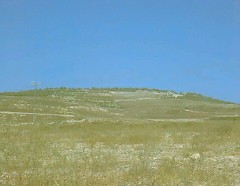
According to the Bible, the kingdom of Solomon was divided after his death in ca.931. In the south, the house of David continued to rule Jerusalem and the kingdom of Judah, and in the north, the kingdom of Israel came into being. In the sixth year of his reign, king Omri (884-873) created a new capital, called Samaria (Šomron), which means something like 'guard post' or 'castle'. The palace of the new city was built on a square platform of about 180x90 meters on a hill that rises more than 100 meters above the surrounding country. It controls the north-south route and an important road from the coast to the Jordan valley.
The archaeological remains of Samaria are very impressive. The oldest city walls were not very heavy (only 1½ meters thick) but were made of ashlar blocks of the highest quality. The houses were built in Phoenician style and beautifully decorated. Archaeologists have found locally carved ivories that illustrate the prophets' reproach that the rich people of Samaria were living in houses of ivory. These plaques show a variety of floral and animal motifs, which suggest influence from Egypt.
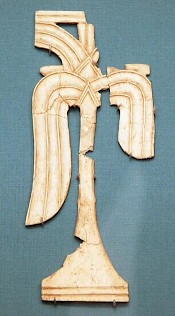
The Biblical account focuses on the history of Judah and tends to neglect Israel, which was, however, a very powerful state. During the golden age of Omri's son Ahab, it had sufficient capital to expand the city walls, making the platform 195x120 meters. The populace lived in houses clustered on the slopes beneath the platform. The city was fully integrated in the international economical, political, and social systems and had several temples, including one for the YHWH and another for the god Ba'al. To orthodox Jews, this was unacceptable, and therefore, the Bible portrays Omri, Ahab, and his wife Jezebel as the archvillains of sacred history, opposed by the saintly prophet Elijah.
However, Israel was unable to withstand the increasing power of Assyria, and in c.724, the kingdom became a province of the empire, called Sâmerîna. The inhabitants who had survived the siege were deported to the east, where the "lost tribes of Israel" were assimilated by the native population. To replace the Samarians, eastern people were sent back, called Cuthaeans. These people mingled with the remaining Israelites and introduced new religious ideas. The Jews from Jerusalem who were to compose the Bible thought the religious orthodoxy of the kings of Israel was already questionable; the introduction of foreign ideas was an additional argument to regard the people of Samaria as heretics.
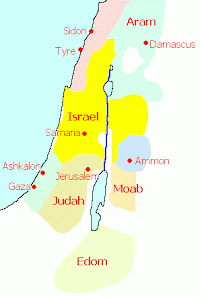
The Samarians will not have cared too much. To them, Jerusalem was a peasant town and the kingdom of Judah was not to be taken seriously. They lived in a far more cosmopolitan world, where polytheism was a matter of civilized behavior. Many Samarians will have believed in YHWH, but saw no reason to worship him in Jerusalem; other Samarians accepted YHWH as one of several gods, something that was not uncommon in Judah either.
The religious pluriformity did not change when the Assyrian empire fell (612) and Judah briefly embarked upon an aggressive northern policy, trying to conquer the former kingdom of Israel. King Josiah of Judah had some success, but the pharaoh of Egypt, Necho II, had similar designs and in 610, he put an end to Josiah's ambitions and life.
The Egyptian supremacy did not last long. The Babylonians, who had overthrown the Assyrians, defeated the Egyptians at Karchemish, and occupied the western provinces of the former Assyrian empire. Samaria now was a minor capital in the empire of the Babylonian king Nebuchadnezzar (605-562). When he conquered Jerusalem in 587, the former kingdom of Judah was added to Sâmerîna. "Yehud", as it was called, remained an appendix of the Samaria province when the Persian king Cyrus the Great (559-530) captured Babylon and allowed the Jews to return home.
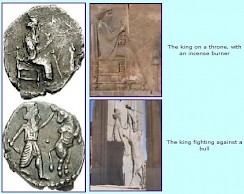
Samaria was loyal to the Persian government. To give an example, there seems to have been a garrison, which was used by Bagoas, a courtier of king Artaxerxes III Ochus, to suppress a rebellion in Judah. Samaria also had the right to mint coins, which show considerable Persian influence.
The relations between the powerful administrative capital of Samaria and the increasingly important monotheistic religious center of Jerusalem deteriorated when the Macedonian conqueror Alexander the Great appeared on the scene in 332. After the defeat of his main opponent, Darius III Codomannus, in the battle of Issus, he needed local allies to supply his forces with provisions during the siege of Tyre.
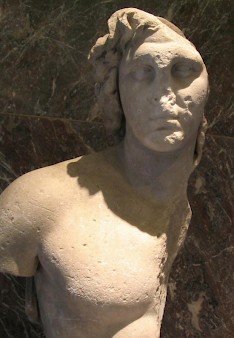
The Samarian leader Sanballat was the first to respond, and immediately asked Alexander's permission to build a temple near Shichem on Mount Gerizim, a few kilometers east of Samaria. It should be noted that a few months or years before, there had been discord among the priests of Jerusalem, and several of members of this order had left the city. They had settled in Samaria, where they were now allowed to build a temple of their own.
This incident is the origin of the Samaritan religious community. From now on, YHWH had two competing sanctuaries, two cults, and two collections of sacred scripture. The five first books of the Bible, the Torah or Pentateuch, have come to us in two versions, one from Samaria and one from Jerusalem. The Samaritan Pentateuch shows that the people of Samaria by now spoke a variety of Aramaic, which is linguistically close to Hebrew. The Samaritan religious community survives until the present day.
Alexander's generosity was not answered. When he had proceeded to Egypt, the Samarians revolted. (Maybe, there was messianic inspiration; the Samaritan religious community knew the concept of the taheb, quite similar to the Messiah.) In the spring of 330, Alexander returned and the Samarians surrendered. From now on, there was a Macedonian garrison in the city, which was to remain something of a European settlement in the land of Israel.
After the death of Alexander, on 11 June 323 in Babylon, Samaria was the most important city in the country known as Coele Syria, which was to be at stake for a series of wars -lasting almost a century- between two of Alexander's successor states, the Ptolemaic and the Seleucid empire. In 200, the Seleucids finally conquered Samaria and Judah.
By now, Samaria had become a more or less Greek city. Unlike Judah, which was focused on its temple and had become monotheistic, the country surrounding Samaria had always been part of the larger Mediterranean world. The cosmopolitan Samarians must have despised their southern neighbors, although they had to agree that they had much in common; on the other hand, the Jews of Jerusalem considered those visiting the sanctuary on Mount Gerizim heretics, and the inhabitants of Samaria racially impure. Yet, they admitted that the northerners were no pagans.
In 165, the southern state liberated itself from the Seleucid rule and a new, independent state came into being, ruled by high priests from the Hasmonaean dynasty. One of them was John Hyrcanus (134-104), who greatly expanded the Jewish state and captured Samaria in 128 or 107. The temple on Mount Gerizim was immediately destroyed. For the first time since the legendary age of David and Solomon, the two kingdoms were united - one capital, one temple, one God. There was also one leader, and John Hyrcanus' successor Alexander Jannaeus assumed the royal title.
Samaria's fate changed for the better when the Roman general Pompey the Great captured Jerusalem in 63 and transformed the country, now called Judaea, into a Roman protectorate. The city and the surrounding country became independent again, although the temple on Mount Gerizim was not restored. In 31 BCE, the Roman commander Octavian gave Samaria to the new king of Judaea, Herod the Great. When Octavian changed his name into Augustus, Herod changed Samaria's name into Sebaste (the Greek form of Augustus).
Herod embellished and enlarged the city, which became even more "Greek" and was among the king's favorite residences. On the site of the old temple of Ba'al, he dedicated a large temple to Augustus, of which the monumental staircase is still visible. Sebastenaeans served in the army of Herod, which meant that they were sometimes used against the Jews of Judaea or Galilee. This did little to increase sympathy between the two nations.
After the death of Herod (4 BCE), Sebaste was given to his son Herod Archelaus, and when the Romans finally annexed Judaea and organized it as a province (6 CE), the city was one of the centers of the new government. The soldiers were integrated as auxiliary troops in the Roman army. We know of an Ala I Sebastenorum (cavalry) that was stationed in Caesarea and a Cohors I Sebastenorum (infantry).
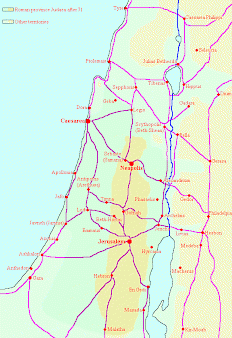
From now on, the history of Samaria-Sebaste is part of the history of Judaea, but not because either the population of the big city or the rest of the inhabitants of the province wanted it like that. There were religious tensions between the Samaritans and the orthodox Jews, there were economic differences between the urban and peasant economies, and the cosmopolitan city was culturally different from many other towns of Judaea. When the Jewish War broke out in 65-66, the inhabitants of Sebaste saw their city razed to the ground by the Jews.
It was rebuilt after the fall of Jerusalem and the destruction of its temple, in 70. Yet, the city was now eclipsed by nearby Shichem, close to Mount Gerizim. Shichem, modern Nablus, had also been refounded -its official name was Neapolis, 'new town'- and we don't know what gave it an advantage. Both towns were situated at the crossing of the north-south route and the main road between the capital of Judaea, Caesarea, and the valley of the river Jordan.
More than a century later, the emperor Septimius Severus (193-211) awarded Sebaste the rank of colonia, which meant that it was regarded as a fully Roman city, with Roman magistrates, Roman citizens, and Roman temples. There may have been a Roman garrison too. When the Christians organized their church, Samaria-Sebaste became the see of a bishop, which it still was in the sixth century.